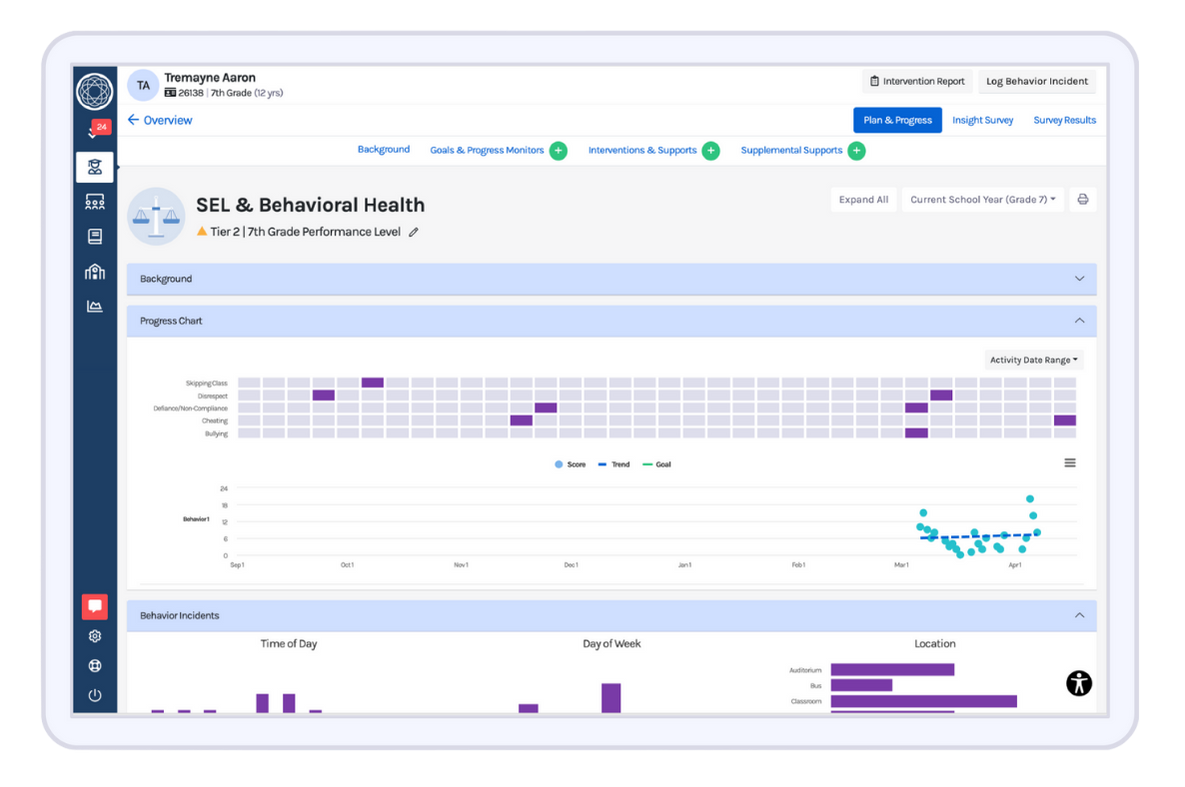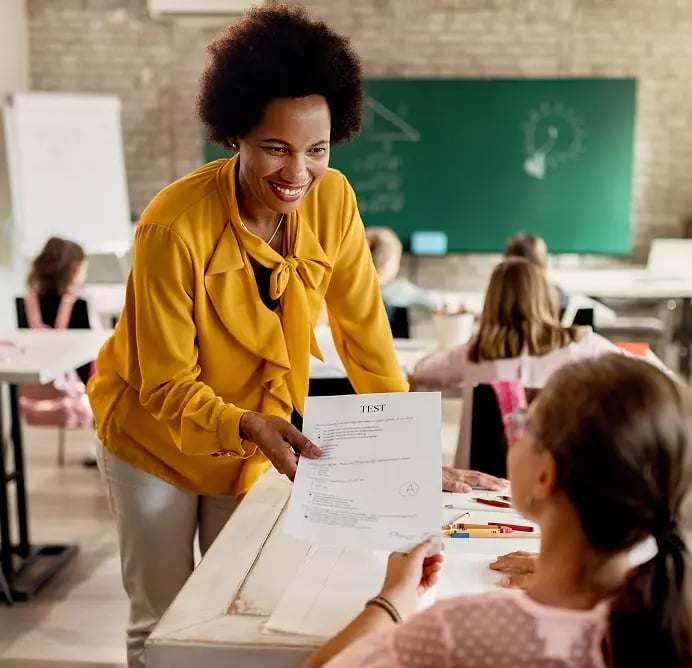A well-structured three-tier system is essential for supporting all students, not just those who struggle. The MTSS framework ensures that every student can achieve academic, social, and emotional success, along with college and career readiness. What supports do you offer students needing intensive help to reach these goals?
Tier 3 Interventions in MTSS Key Takeaways
- Tier 3 = intensive + individualized. Small groups, tailored plans, and wraparound support for highest-need students.
- Be specific in plans. List the exact skill, strategy, person, and schedule—no vague documentation.
- Be specific in plans. List the exact skill, strategy, person, and schedule—no vague documentation.
Let’s explore the crucial role of Tier 3 interventions within MTSS.
How the MTSS Intervention Process Works
MTSS is a responsive data-based system structured to support all students and to identify students who need additional support academically, socially, emotionally, or with attendance. Data-based instruction and interventions are provided, reviewed, and modified based on student progress monitoring and response to intervention.
Reviewing MTSS: Tier 1, Tier 2, and Tier 3.png?width=400&height=300&name=MTSS%20Venn%20diagram%20(2025).png)
- Tier 1 Universal Support: All students receive
research-based differentiated core instruction in the classroom. Instruction is implemented with fidelity, emphasizing grade-level standards and school-wide behavioral expectations. A solid Tier 1 core instruction practice is typically sufficient to meet the needs of 80% of students. This means that 80% or more of the students meet or exceed grade-level expectations as measured by a standardized summative assessment, without needing additional layers of support. - Tier 2 Strategic Support: Students identified through universal screening as lacking specific academic skills or as exhibiting at-risk behavior are provided additional research-based interventions in addition to core instruction. It is typical for 10-15% of students to need targeted skill development to become proficient.
- Tier 3 Intensive Support: Students who have not demonstrated progress with targeted group interventions at Tier 2 require more intensive interventions. Tier 3 interventions are individualized and occur with smaller student-teacher ratios, and may involve wrap-around support for behavioral or attendance needs. It is typical for 3-5% of students to require this level of intensive support.
What are MTSS Interventions?
In MTSS/RTI, interventions are targeted instructional programs, activities, lessons, strategies, or tools used to improve a specific skill.
Intervention plans always need to include the actual intervention that will be used to help students reach their goals.
Identifying Students for an MTSS Intervention
Universal screening is the process of assessing all students to identify students in need of more individualized support (Hughes & Dexter, 2008). Academic and behavioral screening data help determine:
- If core instruction is effective
- Which specific students or groups of students need additional support
Universal screening generates objective information for parents and educators, enabling them to proactively determine students whose needs are not adequately addresseand increasing resource allocation efficiency.
💡Blog: 5 MTSS Screening and Tiering Strategies That Close the Gaps
Selecting and Implementing an MTSS Intervention
Teachers spend a lot of time and effort discussing student needs, creating plans, providing differentiated support, and documenting the work. However, without the right intervention plan, the work becomes a documentation process, not the intended problem-solving practice.
The key components of successful intervention plans are:
SMART Goals
Specific, Measurable, Attainable, Relevant, and Time-bound goals guide intervention efforts and allow clear progress measurement.
Progress Monitoring
Progress monitoring is the process of tracking student growth towards the goal. Short, skill-based assessments are regularly administered to gauge student response to intervention.
Interventions
In MTSS, interventions are targeted instructional programs, activities, lessons, strategies, or tools to improve a skill. Homework help, test prep, and reviews of core content are not considered interventions. Although important, locations and people are also not interventions!
For example, only including in an intervention plan that the student went to the library for support or met with an academic support teacher does not identify what was done to support the student. Instead, be specific about the details of the intervention, and document in such a way that you have the information you need for problem-solving.
-
What skill was targeted?
-
What specifically was done?
-
By whom?
-
How frequently?
-
For how long?
Branching Minds provides technology tools and professional services that help you meet the needs of all students, including those with Tier 3 intervention plans.
📕 Guide: Finding Evidence-Based MTSS Interventions
What are Tier 3 Interventions?
Tier 3 support provides individualized, intensive interventions for students with significant academic or behavioral challenges. These interventions are tailored to the student’s needs and involve multiple stakeholders – teachers, families, support staff, and even wrap-around service providers from the community.
What do Tier 3 Interventions Include?
Tier 3 interventions extend beyond the classroom, offering strategies to improve outcomes during core instruction and often include support for families at home. These plans may involve:
- Individualized problem-solving by a multidisciplinary team. Teams typically meet every 6 weeks.
- 120-135 minutes per week of direct support, depending on the student’s specific needs
- Frequent progress monitoring, at least weekly.
- Wraparound services for additional family support, such as transportation, health, or counseling services.
Tier 3 Intervention Examples
Students with intensive academic or behavioral challenges who have not responded to Tier 1 interventions are reviewed by the MTSS team for Tier 2-supported interventions. The team then customizes a plan to the student's unique needs. The intervention plan incorporates input from various stakeholders and requires the intervention to be implemented with fidelity across multiple settings. Additionally, the MTSS Team at Tier 3 can use specialized problem-solving tools.
Tier 3 Academic Intervention Examples
| A secondary student is assigned a reading intervention class that targets the specific skills the student needs for reading comprehension and vocabulary. The class size is very small to allow for individual assistance and practice. This progress in the class is evaluated quarterly and at the semester to see if the student meets expected goals. |
| An elementary student meets with their teacher briefly before each math block, so that the teacher can pre-teach any new concepts introduced to the class that day. The teacher briefly reviews any skills the student will need to utilize, reminds the student of any relevant prior knowledge, and generally checks to ensure the student is equipped to take on the new concept. The teacher proceeds to teach the new concept to the whole class, and the Tier 3 student can better take on the new information after meeting with the teacher beforehand. |
Tier 3 Behavior and Attendance Intervention Examples
| An elementary student with aggressive behavior is paired with a behavior interventionist to learn appropriate behavior skills. Teachers provide positive and corrective feedback on specific behaviors throughout the day. The behavior interventionist is available for push-in and pull-out support, provides reinforcement, and communicates progress with parents. |
| A secondary student with chronic absenteeism is placed on a special bus route due to their homeless status. An attendance liaison provides a daily morning call to ensure the student is ready for school. The student is enrolled in an after-school program with homework help, along with space to shower and launder clothing. |
📕 Guide: Tier 3 Behavior Intervention Guide for School Leaders
Utilizing Tier 3 Interventions in MTSS: Guiding Decision Making at Tier 3
Decision-making at Tier 3 is more intensive and individualized than at other levels. The following sections discuss considerations during each step of a Tier 3 self-questioning process.
Step 1: Who is Experiencing a Problem, and What Specifically is the Problem?
Tier 3 services are designed to address the needs of students experiencing significant problems and/or unresponsive to Tier 1 and Tier 2 efforts. Schools should establish norms for determining how students enter into Tier 1, 2, or 3 levels of support. It is important to clearly describe the problem in objective, observable terms, so that all stakeholders know they are discussing the same issue.
Step 2: What Intervention Strategies Can Be Used to Reduce the Magnitude or Severity of the Problem?
There are many intervention strategies from which one could choose. For example, several websites provide teacher-friendly intervention resources (e.g., Intervention Central, Free Reading, What Works Cleaning House).
Conducting an analysis of the problem's context and function may be important to assist in the development and selection of an intervention for a specific problem.
The intervention plan should specify timelines for implementing objectives and achieving desired goals. The end goal of this stage is a clearly delineated intervention plan.
Step 3: Did the Student’s Problem Get Resolved as a Result of the Intervention?
The best way to determine whether a student is making progress towards the desired goals in MTSS is to collect ongoing progress monitoring data along with information about the implementation fidelity of the intervention plan itself. The intervention process does not end until the problem is resolved. So, continuous progress monitoring and evaluation are essential parts of an effective MTSS process.
📕Guide: The Ultimate MTSS Progress Monitoring Guide and Toolkit
FAQs on Tier 3 Interventions
What is the Difference Between Tier 2 and Tier 3 Interventions?
Tier 2 support involves small groups of students with specific skill deficits who work with a teacher or interventionist to target that skill using an evidence-based instructional practice or program. Tier 2 instructional methods are similar to those used for the Tier 1 core instruction.
Tier 3 intervention is more intensive and typically requires additional staff members. Group size is smaller, with 1-3 students, and progress monitoring is more frequent.
What is the Purpose of Progress Monitoring in Tier 3?
At the intensive Tier 3 level, progress monitoring must be frequent and specific enough to determine if the student is making sufficient progress toward the goal. If not, the support team will be responsive and adjust or change the intervention to ensure progress.
Is Tier 3 Intervention for Special Education?
Tier 3 interventions are available to all students who need them, regardless of special education status. However, when a student is not responsive to Tier 3 interventions, the support team may suspect a disability and request evaluation for special education services. Students with a special education plan Individualized Education Plan (IEP) receive mandated, specially designed instruction overseen by special education staff.
Identifying, Supporting, and Progress Monitoring Students in Need of Tier 3 Interventions
Tier 3 supports the smallest population, but it is the population with the greatest needs. Students with intensive academic, behavioral, social, and attendance challenges deserve equitable support implemented with fidelity.
About the author
Branching Minds
Branching Minds is a highly respected K-12 services and technology company that leverages the learning sciences and technology to help districts effectively personalize learning through enhancements to their MTSS/RTI practice. Having worked with hundreds of districts across the country, we bring deep expertise in learning sciences, data management and analysis, software design, coaching, and collaboration. Combined with our extensive toolkit of resources, PD, and technology, we provide a system-level solution. We are more than a service or a software provider, we are partners who will deliver sustainable results for educators, and a path to success for every learner.

Behavior Documentation Reimagined 💫
Ready to rethink behavior documentation? Branching Minds helps turn incident data into meaningful action with tools that simplify the process and empower educators.













.png?width=1436&height=956&name=Tier%203%20Interventions%20in%20MTSS%20(preview).png)



.png?width=716&height=522&name=Tier%203%20Behavior%20Support%20Planning%20(preview).png)